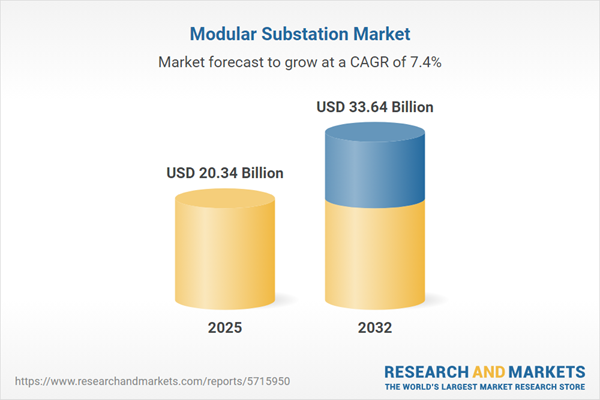Speak directly to the analyst to clarify any post sales queries you may have.
The modular substation market is undergoing rapid transformation as utilities and industries seek agile, digital-ready power infrastructure to address shifting energy patterns and the imperative for grid modernization. Solutions designed for flexibility and resilience are increasingly central to strategies for operational continuity and sustainable power delivery.
Market Snapshot and Growth Trends
The Modular Substation Market grew from USD 18.94 billion in 2024 to USD 20.34 billion in 2025. It is expected to continue growing at a CAGR of 7.43%, reaching USD 33.64 billion by 2032.
This growth reflects the increasing demand for prefabricated, factory-tested substations that streamline deployment, minimize site disruption, and scale with evolving grid requirements. Expansion is driven by distributed energy integration, urban densification, and ongoing infrastructure modernization.
Scope & Segmentation of the Modular Substation Market
This report covers a comprehensive evaluation of the modular substation market’s structure, technology landscape, and regional deployment patterns. Included segmentation details:
- End Users: Commercial, industrial, and utility organizations, each with distinct operational priorities and reliability standards.
- Product Types: Air insulated (metal clad, metal enclosed, pad mounted), gas insulated (SF6 switchgear, vacuum circuit breaker), and hybrid modular substations tailored to cost, space, and performance requirements.
- Voltage Levels: Extra high voltage, high voltage, and medium voltage categories, determining design and insulation approaches.
- Installation Types: Indoor and outdoor formats optimized for variable environmental and spatial constraints.
- Applications: Grid expansion, renewable integration (battery storage, solar, wind), and rural electrification projects.
- Regions: Americas (including North America and Latin America), Europe, Middle East & Africa, and Asia-Pacific. Markets such as the United States, Germany, China, and Brazil feature unique regulatory and grid modernization drivers.
- Key Industry Participants: Siemens, ABB, Schneider Electric, Eaton Corporation, General Electric, Hitachi Energy, Mitsubishi Electric, Toshiba, CG Power, and Powell Industries.
Key Takeaways for Senior Decision-Makers
- Modular substations allow utilities and businesses to accelerate deployment while reducing site complexity and manual labor needs.
- Standardized, factory-tested modules streamline regulatory processes and support higher construction quality and safety.
- Digitalization trends, including digital twins and embedded analytics, are transforming asset management from scheduled to condition-based maintenance, improving reliability and cost control.
- Sustainability pressures are driving innovation in materials and design, such as low-carbon steel components and eco-friendly insulating media aligned with emerging compliance mandates.
- Regional variations significantly impact procurement strategies and deployment timelines, highlighting the importance of localized approaches and vendor partnerships.
- Industry players are gaining a competitive edge by integrating intelligent automation, fostering turnkey service agreements, and adopting advanced manufacturing techniques such as 3D printing and robotic assembly.
Tariff Impact on Modular Substation Supply Chains
Recent United States tariffs on switchgear, transformers, and control panels complicate procurement, increasing both project costs and supply chain risk. Firms are responding by localizing production, building regional supplier networks, and renegotiating contracts to manage volatility. These changes place a premium on supplier qualification processes and adaptive sourcing strategies for uninterrupted delivery and compliance.
Methodology & Data Sources
This report utilizes a blend of primary and secondary research, including direct interviews with leading manufacturers, system integrators, utilities, and end users. Supplementary desk research across technical publications and regulatory filings ensures quantitative and qualitative accuracy. Data triangulation and rigorous peer review uphold reliability.
Why This Report Matters
- Empowers decision-makers to benchmark procurement and deployment approaches for modular substations against changing regulatory, technological, and market environments.
- Provides clarity on the interplay between digital transformation, sustainability mandates, and regional trade policies.
- Enables organizations to assess supplier capabilities, partnership opportunities, and risk mitigation strategies to drive project success and sustained growth.
Conclusion
Modular substations are redefining the grid landscape, offering scalable, resilient solutions for diverse market needs. This report delivers the strategic analysis required to navigate complexity, capitalize on innovation, and ensure operational continuity in a progressing energy ecosystem.
Additional Product Information:
- Purchase of this report includes 1 year online access with quarterly updates.
- This report can be updated on request. Please contact our Customer Experience team using the Ask a Question widget on our website.
Table of Contents
3. Executive Summary
4. Market Overview
7. Cumulative Impact of Artificial Intelligence 2025
Companies Mentioned
The companies profiled in this Modular Substation market report include:- Siemens Aktiengesellschaft
- ABB Ltd.
- Schneider Electric SE
- Eaton Corporation plc
- General Electric Company
- Hitachi Energy Ltd.
- Mitsubishi Electric Corporation
- Toshiba Energy Systems & Solutions Corporation
- CG Power and Industrial Solutions Limited
- Powell Industries, Inc.
Table Information
| Report Attribute | Details |
|---|---|
| No. of Pages | 197 |
| Published | October 2025 |
| Forecast Period | 2025 - 2032 |
| Estimated Market Value ( USD | $ 20.34 Billion |
| Forecasted Market Value ( USD | $ 33.64 Billion |
| Compound Annual Growth Rate | 7.4% |
| Regions Covered | Global |
| No. of Companies Mentioned | 11 |









